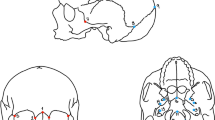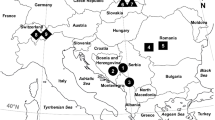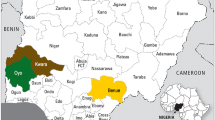Abstract
Fluctuating asymmetry was determined for six cranial measurements in an age-diverse sample of 138 individuals ofMacaca fascicularis. These data were used to choose among four hypotheses concerning the etiology of developmental noise. The hypotheses considered are (1) that developmental noise represents asymmetry in the causal history of a developing organism's interaction with the environment, (2) that it represents stochasticity in the mechanics of growth and induction, (3) that it reflects variation in the initial conditions of a developmental process, and (4) that it represents the random accumulation of noise at a level below that of morphogenetic mechanism. These hypotheses were tested against predictions concerning the intraspecific patterning of fluctuating asymmetry against age and size and the covariation of asymmetry values. Only the predictions of the fourth hypothesis were confirmed by results of this study. These results provide evidence for the view that developmental noise, as reflected by fluctuating asymmetry, is an intrinsic property of developmental systems, and not merely produced by the complexity of the organism's interaction with the environment.
Similar content being viewed by others
References
Bader, R. S. (1965). Fluctuating asymmetry in the dentition of the house mouse.Growth 29: 291–300.
Bailit, H. L., Workman, P. L., Niswander, J. D., and MacLean, C. J. (1970). Dental asymmetry as an indicator of genetic and environmental conditions in human populatons.Hum. Biol. 42: 626–638.
Biémont, C. (1983). Homeostasis, enzymatic heterozygosity and inbreeding depression in natural populations ofDrosophila melanagaster.Genetica 61: 179–189.
Brizee, K. R., and Dunlap, W. P. (1986). Growth. In Dukelow, W. R., and Erwin, J. (eds.),Comparative Primate Biology, Vol. 3. Reproduction and Development, Alan R. Liss, New York, pp. 363–414.
Corruccini, R. S., and Potter, R. H. Y. (1981). Developmental correlates of crown component asymmetry and occlusal discrepancy.Am. J. Phys. Anthropol. 55: 21–31.
Clarke, G. M., Brand, G. W., and Whitten, M. J. (1986). Fluctuating asymmetry: A technique for measuring developmental stress caused by inbreeding.Austral. J. Biol. Sci. 39: 145–53.
Doyle, W. J., and Johnston, O. (1983). On the meaning of increased fluctuating dental asymmetry: A cross populational study.Am. J. Phys. Anthropol. 46: 127–134.
Doyle, W. J., Kelley, C., and Siegel, M. I. (1977). The effects of audiogenic stress on the growth of long bones in the laboratory rat (Rattus norvegicus).Growth 41: 183–189.
Falk, D. (1978). Cerebral asymmetry in Old World monkeys.Acta Anat. 101: 334–339.
Felley, J. (1980). Analysis of morphology and asymmetry in bluegill sunfish (Lepomis macrochirus) in the southeastern United States.Copeia 1: 18–29.
Ferguson, M. M. (1986). Developmental stability of rainbow trout hybrids: Genomic coadaptation or heterozygosity.Evolution 40: 323–330.
Frazer, J. F. D. (1974). Species variation in the foetal growth rates of eutherian mammals.J. Zool. Lond. 174: 481.
Goose, D. H. (1982).Human Dentofacial Growth, Pergamon Press, Oxford.
Joffe, R. (1969). Prenatal determinants of behavior.International Series of Monographs in Experimental Psychology, Pergamon Press, London.
Jones, J. S. (1987). An asymmetrical view of fitness.Nature 325: 298–299.
Kiesler, J. A., Groenveld, H. T., and Preston, C. B. (1986). Fluctuating dental asymmetry as a measure of ontogenetic canalization in man.Am. J. Phys. Anthropol. 71: 437–444.
Kohn, L. A., and Bennet, K. A. (1986). Fluctuating asymmetry in fetuses of diabetic Rhesus Macaques.Am. J. Phys. Anthropol. 71: 477–483.
Kobyliansky, E., and Livshits, G. (1989). Age dependent changes in morphometric and biochemical traits.Ann. Hum. Biol. 16(3): 237–247.
Leamy, L. (1986). Directional selection and developmental stability: Evidence from fluctuating asymmetry of dental characters in mice.Hereditas. 57: 381–388.
Leamy, L., and Atchley, W. (1985). Directional selection and developmental asymmetry: Evidence from fluctuating asymmetry of morphometric characters of rats.Growth 49: 8–18.
Leary, R. F., Allendorf, F. W., and Knudsen, K. L. (1983). Developmental stability and rainbow heterozygosity in rainbow trout.Nature 301: 71–72.
Leary, R. F., Allendorf, F. W., and Knudsen, K. L. (1985). Inheritance of meristic variation and the evolution of developmental stability in the rainbow trout.Evolution 39(2): 308–314.
Mather, K. (1953). Genetical control of stability in development.Heredity 7: 297–336.
McGrath, J. W., Cheverud, J. M., and Buikstra, J. E. (1984). Genetic correlations between sides and heritability of asymmetry for nonmetric traits in Rhesus Macaques.Am. J. Phys. Anthropol. 64: 401–411.
Modi, W. S., Wayne, R. K., and O'Brien, S. J. (1987). Analysis of fluctuating asymmetry in cheetahs.Evolution 41(1): 227–228.
Newell Morris, L., and Fahrenbuch, C. E. (1985). Practical and evolutionary considerations for use of the nonhuman primate model in prenatal research. In Watts, E. S. (ed.),Nonhuman Primate Models for Human Growth and Development, Alan R. Liss, New York, pp. 1–8.
Noss, J. F., Scott, G. R., Yap Potter, R. H., and Dahlberg, A. (1983). Fluctuating asymmetry in molar dimensions and discrete morphological traits in Pima Indians.Am. J. Phys. Anthropol. 61: 437–445.
Palmer, A. R. (1986). Inferring relative levels of genetic variability in fossils: The link between heterozygosity and fluctuating asymmetry.Paleobiology 12(1): 1–5.
Palmer, A. R., and Strobeck, C. (1986). Fluctuating asymmetry: Measurement, analysis, patterns.Ann. Rev. Ecol. System. 17: 391–421.
Patterson, B. D., and Patton, J. L. (1990). Fluctuating asymmetry and allozymic heterozygosity among natural populations of pocket gophers (Thomomys bottae).Biol. J. Linn. Soc. 40: 21–36.
Perzigian, A. J. (1977). Fluctuating dental asymmetry: Variation among skeletal populations.Am. J. Phys. Anthropol. 47: 81–88.
Reeve, E. C. R. (1960). Some genetic tests on asymmetry of sternopleural chaeta number inDrosophila. Genet. Res. 1: 151–172.
Saunders, S. R., and Mayhall, J. T. (1982). Fluctuating asymmetry of dental morphological traits: New interpretations.Hum. Biol. 54(4): 789–799.
Schultz, A. H. (1933). Growth and development. In Hartman, C. G., and Straus, W. L. (eds.),The Anatomy of the Rhesus Monkey, Williams and Wilkins, Baltimore, pp. 10–28.
Sciulli, P. W., Doyle, W. J., Kelley, C., Siegel, P., and Siegel, M. I. (1979). The interaction of stressors in the induction of increased levels of fluctuating asymmetry in the laboratory rat.Am. J. Phys. Anthropol. 50: 279–284.
Siegel, M. I., and Doyle, W. J. (1975). Stress and fluctuating limb asymmetry in various species of rodents.Growth 39: 363–369.
Siegel, M. I., and Smookler, H. H. (1973). Fluctuating dental asymmetry and audiogenic stress.Growth 37: 35–39.
Sokal, R. R., and Rohlf, F. J. (1981).Biometry, 2nd ed., W. H. Freeman, New York.
Soulé, M. E. (1979). Heterozygosity and developmental stability: Another look.Evolution 33(1): 396–401.
Soulé, M. E. (1982). Allomeric variation. 1. The theory and some consequences.Am. Nat. 120(6): 751–764.
Sullivan, W. E. (1933). Skeleton and joints. In Hartman, C. G. (ed.),The Anatomy of the Rhesus Monkey, Hafner, New York.
Swindler, D. R. (1985). Nonhuman primate dental development and its relationship to human dental development, In Watts, E. S. (ed.),Nonhuman Primate Models for Human Growth and Development. Alan R. Liss, New York, pp. 67–94.
Van Valen, L. M. (1962). A study of fluctuating asymmetry.Evolution 16(2): 125–142.
Van Valen, L. M. (1978). The statistics of variation.Evol. Theory 4: 33–43.
Van Valen, L. M. (1982). Homology and causes.J. Morphol. 173: 305–312.
Vrijenhoek, R. C., and Lerman, S. (1982). Heterozygosity and developmental stability under sexual and asexual breeding systems.Evolution 36(4): 768–776.
Waddington, C. H. (1957).The Strategy of the Genes, Macmillan, New York.
Watts, E. S. (1986). Skeletal development. In Dukelow, W. R., and Erwin, J. (eds.),Comparative Primate Biology, Vol. 3. Reproduction and Development, Alan R. Liss, New York, pp. 425–440.
Wayne, R. K., Modi, W. S., and O'Brien, S. J. (1986). Morphological variability and asymmetry in the cheetah (Acynonyx jubatus), a genetically uniform species.Evolution 40(1): 78–85.
Wooten, M. C., and Smith, M. H. (1986). Fluctuating asymmetry and genetic variability in a natural population ofMus musculus.J. Mammal. 67(4): 725–732.
Yablokov, A. V. (1974).Variability of Mammals, New Delhi, Amerind.
Author information
Authors and Affiliations
Rights and permissions
About this article
Cite this article
Hallgrímsson, B. Fluctuating asymmetry inMacaca fascicularis: A study of the etiology of developmental noise. International Journal of Primatology 14, 421–443 (1993). https://doi.org/10.1007/BF02192775
Received:
Accepted:
Issue Date:
DOI: https://doi.org/10.1007/BF02192775




